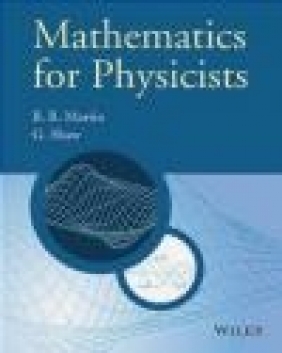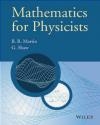Mathematics for Physicists
Brian Martin, Graham Shaw
Mathematics for Physicists
Brian Martin, Graham Shaw
- Producent: Blackwell Science
- Rok produkcji: 2015
- ISBN: 9780470660225
- Ilość stron: 582
- Oprawa: Miękka
Niedostępna
Opis: Mathematics for Physicists - Brian Martin, Graham Shaw
Mathematics for Physicists is a relatively short volume covering all the essential mathematics needed for a typical first degree in physics, from a starting point that is compatible with modern school mathematics syllabuses. Early chapters deliberately overlap with senior school mathematics, to a degree that will depend on the background of the individual reader, who may quickly skip over those topics with which he or she is already familiar. The rest of the book covers the mathematics that is usually compulsory for all students in their first two years of a typical university physics degree, plus a little more. There are worked examples throughout the text, and chapter-end problem sets. Mathematics for Physicists features: * Interfaces with modern school mathematics syllabuses * All topics usually taught in the first two years of a physics degree * Worked examples throughout * Problems in every chapter, with answers to selected questions at the end of the book and full solutions on a website
This text will be an excellent resource for undergraduate students in physics and a quick reference guide for more advanced students, as well as being appropriate for students in other physical sciences, such as astronomy, chemistry and earth sciences.Editors preface to the Manchester Physics Series xi
Authors preface xiii
Notes and website information xv
1 Real numbers, variables and functions 1
1.1 Real numbers 1
1.1.1 Rules of arithmetic: rational and irrational numbers 1
1.1.2 Factors, powers and rationalisation 4
1.1.3 Number systems 6
1.2 Real variables 9
1.2.1 Rules of elementary algebra 9
1.2.2 Proof of the irrationality of 2 11
1.2.3 Formulas, identities and equations 11
1.2.4 The binomial theorem 13
1.2.5 Absolute values and inequalities 17
1.3 Functions, graphs and co-ordinates 20
1.3.1 Functions 20
1.3.2 Cartesian co-ordinates 23
Problems 1 28
2 Some basic functions and equations 31
2.1 Algebraic functions 31
2.1.1 Polynomials 31
2.1.2 Rational functions and partial fractions 37
2.1.3 Algebraic and transcendental functions 41
2.2 Trigonometric functions 41
2.2.1 Angles and polar co-ordinates 41
2.2.2 Sine and cosine 44
2.2.3 More trigonometric functions 46
2.2.4 Trigonometric identities and equations 48
2.2.5 Sine and cosine rules 51
2.3 Logarithms and exponentials 53
2.3.1 The laws of logarithms 54
2.3.2 Exponential function 56
2.3.3 Hyperbolic functions 60
2.4 Conic sections 63
Problems 2 68
3 Differential calculus 71
3.1 Limits and continuity 71
3.1.1 Limits 71
3.1.2 Continuity 75
3.2 Differentiation 77
3.2.1 Differentiability 78
3.2.2 Some standard derivatives 80
3.3 General methods 82
3.3.1 Product rule 83
3.3.2 Quotient rule 83
3.3.3 Reciprocal relation 84
3.3.4 Chain rule 86
3.3.5 More standard derivatives 87
3.3.6 Implicit functions 89
3.4 Higher derivatives and stationary points 90
3.4.1 Stationary points 92
3.5 Curve sketching 95
Problems 3 98
4 Integral calculus 101
4.1 Indefinite integrals 101
4.2 Definite integrals 104
4.2.1 Integrals and areas 105
4.2.2 Riemann integration 108
4.3 Change of variables and substitutions 111
4.3.1 Change of variables 111
4.3.2 Products of sines and cosines 113
4.3.3 Logarithmic integration 115
4.3.4 Partial fractions 116
4.3.5 More standard integrals 117
4.3.6 Tangent substitutions 118
4.3.7 Symmetric and antisymmetric integrals 119
4.4 Integration by parts 120
4.5 Numerical integration 123
4.6 Improper integrals 126
4.6.1 Infinite integrals 126
4.6.2 Singular integrals 129
4.7 Applications of integration 132
4.7.1 Work done by a varying force 132
4.7.2 The length of a curve 133
4.7.3 Surfaces and volumes of revolution 134
4.7.4 Moments of inertia 136
Problems 4 137
5 Series and expansions 143
5.1 Series 143
5.2 Convergence of infinite series 146
5.3 Taylor s theorem and its applications 149
5.3.1 Taylor s theorem 149
5.3.2 Small changes and l H opital s rule 150
5.3.3 Newton s method 152
5.3.4 Approximation errors: Euler s number 153
5.4 Series expansions 153
5.4.1 Taylor and Maclaurin series 154
5.4.2 Operations with series 157
5.5 Proof of d Alembert s ratio test 161
5.5.1 Positive series 161
5.5.2 General series 162
5.6 Alternating and other series 163
Problems 5 165
6 Complex numbers and variables 169
6.1 Complex numbers 169
6.2 Complex plane: Argand diagrams 172
6.3 Complex variables and series 176
6.3.1 Proof of the ratio test for complex series 179
6.4 Euler s formula 180
6.4.1 Powers and roots 182
6.4.2 Exponentials and logarithms 184
6.4.3 De Moivre s theorem 185
6.4.4 Summation of series and evaluation of integrals 187
Problems 6 189
7 Partial differentiation 191
7.1 Partial derivatives 191
7.2 Differentials 193
7.2.1 Two standard results 195
7.2.2 Exact differentials 197
7.2.3 The chain rule 198
7.2.4 Homogeneous functions and Euler s theorem 199
7.3 Change of variables 200
7.4 Taylor series 203
7.5 Stationary points 206
7.6 Lagrange multipliers 209
7.7 Differentiation of integrals 211
Problems 7 214
8 Vectors 219
8.1 Scalars and vectors 219
8.1.1 Vector algebra 220
8.1.2 Components of vectors: Cartesian co-ordinates 221
8.2 Products of vectors 225
8.2.1 Scalar product 225
8.2.2 Vector product 228
8.2.3 Triple products 231
8.2.4 Reciprocal vectors 236
8.3 Applications to geometry 238
8.3.1 Straight lines 238
8.3.2 Planes 241
8.4 Differentiation and integration 243
Problems 8 246
9 Determinants, Vectors and Matrices 249
9.1 Determinants 249
9.1.1 General properties of determinants 253
9.1.2 Homogeneous linear equations 257
9.2 Vectors in n Dimensions 260
9.2.1 Basis vectors 261
9.2.2 Scalar products 263
9.3 Matrices and linear transformations 265
9.3.1 Matrices 265
9.3.2 Linear transformations 270
9.3.3 Transpose, complex, and Hermitian conjugates 273
9.4 Square Matrices 274
9.4.1 Some special square matrices 274
9.4.2 The determinant of a matrix 276
9.4.3 Matrix inversion 278
9.4.4 Inhomogeneous simultaneous linear equations 282
Problems 9 284
10 Eigenvalues and eigenvectors 291
10.1 The eigenvalue equation 291
10.1.1 Properties of eigenvalues 293
10.1.2 Properties of eigenvectors 296
10.1.3 Hermitian matrices 299
10.2 Diagonalisation of matrices 302
10.2.1 Normal modes of oscillation 305
10.2.2 Quadratic forms 308
Problems 10 312
11 Line and multiple integrals 315
11.1 Line integrals 315
11.1.1 Line integrals in a plane 315
11.1.2 Integrals around closed contours and along arcs 319
11.1.3 Line integrals in three dimensions 321
11.2 Double integrals 323
11.2.1 Green s theorem in the plane and perfect differentials 326
11.2.2 Other co-ordinate systems and change of variables 330
11.3 Curvilinear co-ordinates in three dimensions 333
11.3.1 Cylindrical and spherical polar co-ordinates 334
11.4 Triple or volume integrals 337
11.4.1 Change of variables 338
Problems 11 340
12 Vector calculus 345
12.1 Scalar and vector fields 345
12.1.1 Gradient of a scalar field 346
12.1.2 Div, grad and curl 349
12.1.3 Orthogonal curvilinear co-ordinates 352
12.2 Line, surface, and volume integrals 355
12.2.1 Line integrals 355
12.2.2 Conservative fields and potentials 359
12.2.3 Surface integrals 362
12.2.4 Volume integrals: moments of inertia 367
12.3 The divergence theorem 368
12.3.1 Proof of the divergence theorem and Green s identities 369
12.3.2 Divergence in orthogonal curvilinear co-ordinates 372
12.3.3 Poisson s equation and Gauss theorem 373
12.3.4 The continuity equation 376
12.4 Stokes theorem 377
12.4.1 Proof of Stokes theorem 378
12.4.2 Curl in curvilinear co-ordinates 380
12.4.3 Applications to electromagnetic fields 381
Problems 12 384
13 Fourier analysis 389
13.1 Fourier series 389
13.1.1 Fourier coefficients 390
13.1.2 Convergence 394
13.1.3 Change of period 398
13.1.4 Non-periodic functions 399
13.1.5 Integration and differentiation of Fourier series 401
13.1.6 Mean values and Parseval s theorem 405
13.2 Complex Fourier series 407
13.2.1 Fourier expansions and vector spaces 409
13.3 Fourier transforms 410
13.3.1 Properties of Fourier transforms 414
13.3.2 The Dirac delta function 419
13.3.3 The convolution theorem 423
Problems 13 426
14 Ordinary differential equations 431
14.1 First-order equations 433
14.1.1 Direct integration 433
14.1.2 Separation of variables 434
14.1.3 Homogeneous equations 435
14.1.4 Exact equations 438
14.1.5 First-order linear equations 440
14.2 Linear ODEs with constant coefficients 441
14.2.1 Complementary functions 442
14.2.2 Particular integrals: method of undetermined coefficients 446
14.2.3 Particular integrals: the D-operator method 448
14.2.4 Laplace transforms 453
14.3 Euler s equation 459
Problems 14 461
15 Series solutions of ordinary differential equations 465
15.1 Series solutions 465
15.1.1 Series solutions about a regular point 467
15.1.2 Series solutions about a regular singularity: Frobenius method 469
15.1.3 Polynomial solutions 475
15.2 Eigenvalue equations 478
15.3 Legendre s equation 481
15.3.1 Legendre functions and Legendre polynomials 482
15.3.2 The generating function 487
15.3.3 Associated Legendre equation 490
15.3.4 Rodrigues formula 492
15.4 Bessel s equation 494
15.4.1 Bessel functions 495
15.4.2 Properties of non-singular Bessel functions J (x) 499
Problems 15 502
16 Partial differential equations 507
16.1 Some important PDEs in physics 510
16.2 Separation of variables: Cartesian co-ordinates 511
16.2.1 The wave equation in one spatial dimension 512
16.2.2 The wave equation in three spatial dimensions 515
16.2.3 The diffusion equation in one spatial dimension 518
16.3 Separation of variables: polar co-ordinates 520
16.3.1 Plane-polar co-ordinates 520
16.3.2 Spherical polar co-ordinates 524
16.3.3 Cylindrical polar co-ordinates 529
16.4 The wave equation: d Alembert s solution 532
16.5 Euler equations 535
16.6 Boundary conditions and uniqueness 538
16.6.1 Laplace transforms 540
Problems 16 544
Answers to selected problems 549
Index 559
Szczegóły: Mathematics for Physicists - Brian Martin, Graham Shaw
Tytuł: Mathematics for Physicists
Autor: Brian Martin, Graham Shaw
Producent: Blackwell Science
ISBN: 9780470660225
Rok produkcji: 2015
Ilość stron: 582
Oprawa: Miękka
Waga: 1.12 kg

























